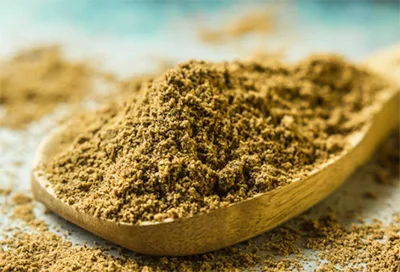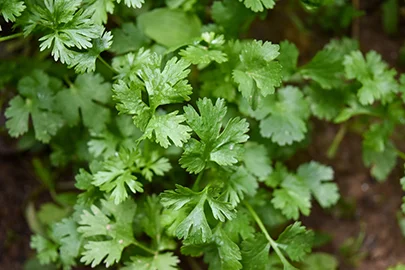You are here because you most likely ran out of coriander, and you are already in the kitchen and ready to whip out some delicious dishes. If you don't have any corianders at home, don't panic, as there are many great coriander substitutes that you may already have right in your kitchen. Below, we will discuss the best
What Is Coriander?
The best way to determine a coriander substitute is to know exactly what we are replacing. What is coriander? What flavor profile do they add to your dish?
Coriander is a member of the parsley family and is also called Chinese parsley or cilantro (more on that below). Plain coriander has a bitter, citrus-like flavor, like lemon or lime, and a strong aroma.
However, not everyone cares for it or even enjoys it - or at least for the leaves. Some people describe fresh cilantro as refreshing and light, but others describe it as "soapy." When finding the best coriander substitute, we will have to consider these flavor profiles.
Coriander frequently uses various spice blends such as garam masala, curry, shawarma seasoning, pickling recipes, and even brewing beer. Its versatile nature allows it to contribute to the distinct flavors and aromas found in these culinary and beverage applications.
Aside from being used in the spice mix, coriander can be used standalone either in-ground or as whole coriander seeds.
Coriander Vs. Cilantro
In the United States, the coriander leaves and stems are called "cilantro," while the seeds are called "coriander." Other countries reverse each term or use the same word for all plant parts. Before you search for a substitute, first understand whether you are substituting for the leaves or the seeds, as they offer a different taste and function.
The seed is frequently used to add flavor to brine meat or pickling vegetables, and the leaves are used as an herb or a garnish.
Best Substitutes For Coriander Seeds

Coriander seeds have been treasured from India and China to the Middle East to Latin America for centuries. Unlike the leaves, the whole coriander seeds taste warmer than coriander leaves or even ground coriander seeds. These dried, whole coriander seeds are used frequently in teas, for pickling, in meat rubs, brine, and atop roasted vegetables. Here are the best coriander substitute options if the recipe calls for coriander seeds:
Ground Coriander
The best substitute for coriander seeds is ground coriander. If your recipe specifically calls for coriander seeds but only has the ground version on hand, you can easily substitute ground coriander for it. For every teaspoon of coriander seeds required, simply use 3/4 teaspoon of ground coriander instead. This precise measurement ensures that you maintain the intended flavor and aroma in your dish.
Cumin Seeds
Cumin seeds are often paired with coriander in many recipes. Cumin has a warmer, spicier flavor than coriander and is often found in Middle Eastern and Latin American cuisine. Coriander and cumin both have earthy flavors, but cumin is heavier than the lighter, fresh flavor of coriander. Cumin will substitute well for coriander seed if it's that earthiness that you're going for rather than the citric flavor making this one of the best coriander substitutes.
Caraway Seeds
Caraway and coriander are both in the parsley family, and so substitute well for each other. Caraway seeds have a nutty, slightly bittersweet flavor profile with touches of anise and citrus. Caraway seeds are slightly sweeter than coriander, so start with a pinch and taste the dish before adding more.
Caraway seeds serve as an excellent substitute for coriander in recipes where the distinct flavor of coriander takes a backseat but still adds to the overall aroma and complexity of the dish. Caraway seeds work particularly well as a replacement in recipes like bread, stews, and sauerkraut, where coriander plays a complementary rather than a central role. If you find yourself without coriander, try experimenting with caraway seeds in these types of dishes to achieve a similar aromatic enhancement.
Fennel Seeds
Both fennel and coriander contain a substance called anethole. The anethole gives both an anise licorice flavor so that you can use one in place of the other. However, fennel won't have the citric taste and is more bitter than coriander.
Fennel seeds are commonly employed as a coriander substitute in dishes like soups, stews, and roasted root vegetables. They also serve as a viable alternative in spice blends and marinades that include coriander as an ingredient. When a recipe calls for coriander, and you find yourself without it, fennel seeds can step in to offer a comparable aromatic and flavor profile. Their use adds a similar dimension to your dish, ensuring that you still enjoy a satisfying culinary experience.
Best Substitutes For Ground Coriander
Ground coriander exhibits a slightly more bitter flavor compared to whole coriander, and it is commonly utilized as a powdered form in marinades and curry pastes. If a recipe calls for coriander seeds, but you don't have any on hand, here are some great ground coriander substitute options:

Ground Cumin
Ground cumin is made from dried seeds of Cuminum, and this spice is commonly found on people's spice racks. While cumin doesn't match the exact flavor profile of coriander, it shares a similar earthy and nutty flavor, making it a good coriander substitute.
Ground cumin is a suitable substitute for coriander in recipes where the dominant flavor is not dependent on coriander, but it still adds to the overall flavor profile. It is commonly used as an alternative in dishes like chili, curries, and Mexican cuisine, where coriander serves as a complementary element rather than the main highlight.
When using cumin as a substitute, use a 1:1 exchange ratio.
Caraway
In terms of aromatic profile, caraway is the closest match, and it comes in both whole seeds and ground powder. Caraway contains the same aromatic oils as coriander, making it one of the best substitutes for coriander. However, caraway is not a commonly used spice, so the chances are you may not have this on your spice rack.
Caraway is a particularly fitting choice for dishes like bread, sauerkraut, stews, and hearty European cuisine, where coriander functions as a supporting element. In these recipes, caraway can effectively replicate the complementary flavor and aromatic notes typically associated with coriander.
But if you don't have a ground caraway, you can use a 1:1 ratio substitute.
Fennel Seeds
Fennel seeds have a very different flavor profile than coriander but have the same earthy tones. Even though the flavor may be different, it can still complement your dish nicely.
Fennel seeds shine as the ideal substitute in dishes like soups, stews, roasted vegetables, and spice blends, where coriander seeds play a supporting role. They offer a similar flavor profile to coriander and work exceptionally well in these recipes.
When using fennel seeds as the substitute, use a 1:1 exchange ratio.
Garam Masala
Garam masala is used in many Indian dishes and is a spice blend containing ground coriander, cumin, cinnamon, clove, turmeric, and black pepper. By adding garam masala to a dish, you'll add coriander! But you'll be adding many other flavors as well.
Also, turmeric in garam masala will quickly turn the entire dish into a yellow color, but it offers great health benefits.
When using Garam Masala as the substitute, you can use a 1:1 ratio substitution.
Curry Powder
Curry powder is another Indian spice blend containing coriander, turmeric, ginger, chili powder, cardamom, etc. It is popular in Indian and Asian dishes and is characterized by a rich golden hue.
Because curry powders contain coriander, this spice mix can be a great substitute and addition to your dish. But, again, you'll also be adding yellow turmeric and many other spices that might go against the desired flavor of your dish. Curry powder is a great substitute for grilled meat or roasted veggies.
When using curry powder as a substitute, you can use a 1:1 ratio substitution. However, depending on what other spices you may be putting in your dish, it is recommended that you start with a small amount of curry powder and work your way up to ensure the curry powder doesn't overpower your dish.
Substitutes For Coriander Leaves

Coriander and cilantro originate from the same plant. Coriander leaves are commonly known as cilantro. Although ground coriander is generally accepted, some individuals who don't mind the powdered version dislike cilantro, finding it reminiscent of a soapy taste.
If your recipe calls for cilantro as a garnish, it may not be a setback if you don't have any available. When substituting coriander seeds, whole or ground form, we typically turn to alternative spices. However, when it comes to coriander leaves or cilantro, fresh herbs serve as a suitable replacement.
Parsley
Coriander is in the same plant family as parsley, so parsley itself is a perfect coriander substitute! Fresh parsley is crisp, slightly peppery, and somewhat bitter. However, it lacks a lemony flavor. If using parsley to substitute coriander, consider tossing the fresh leaves with a couple of drops of lemon or lime juice.
When using dried parsley as the coriander substitute, you can use a 1:1 ratio substitution.
Basil
Basil is from the mint family, a common herb used in Thai and Italian cuisine. Basil can be a great substitute for coriander as it has a similar taste profile with a hint of mint and a slight anise flavor.
Italian basil is the most common variety you can find on the market, and it is a bit sweet. Thai basil, however, has a distinct taste from Italian basil and has a very similar flavor profile to the coriander plant. However, Thai basil doesn't have the citric taste of coriander, but they both share the licorice and anise flavor.
Fresh basil is also a better choice as it is less potent than dried basil. Dried basil can be used in a 1:1 exchange ratio, and fresh basil is a little harder to find the exact ratio.
Oregano
Dried oregano is often used in Italian cuisine, but the fresh herb can be used as a coriander substitute. It has an earthy flavor, similar to coriander, and it is also somewhat minty. The mint and citrus flavors are not the same, but both are light and refreshing. In a pinch, oregano could save your dish!
You can use a 1:1 exchange ratio when using oregano as the substitute.
Dill
Fresh dill is a popular coriander substitute because they both have an earthy flavor. Dill can be a nice choice if you don't like coriander taste. But you will still get the peppery bitterness of coriander in dill.
Dill can be very powerful, and we recommend that you start with a small amount when replacing coriander and work your way up, starting with half of what the recipe calls for in coriander.
Tarragon
Tarragon and coriander share very similar flavors. Tarragon has thin leaves, a bittersweet taste, and a citric aroma. It has a slight taste of lemon and licorice, just like coriander. However, it also has a hint of vanilla, pepper, and mint. Be sure to taste your dish as you add tarragon to keep your flavors in balance.
You can use a 1:1 exchange ratio when using tarragon as a substitute.
Herb Mixtures
Depending on your choice, a herb mixture may do the trick. Chopping up some chive, tarragon, rosemary, and other herbs can add a touch of freshness to your dish.
If you have a herb blend at home, it may include coriander, especially if you have Italian seasoning.
